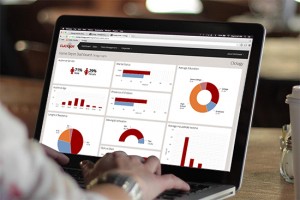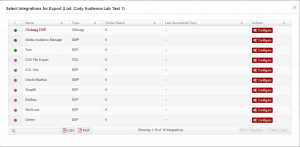 Audience Lab is a secret weapon for political advertisers who are interesting in only reaching their target audience surgically every time instead of wasting time, money, and goodwill by firing for effect at best and carpet bombing at worst.
Audience Lab is a secret weapon for political advertisers who are interesting in only reaching their target audience surgically every time instead of wasting time, money, and goodwill by firing for effect at best and carpet bombing at worst.
If you’ve ever run a successful retargeting ad campaign, you know how powerful the effect is of being able to associate browsers to sites through cookies. What Audience Lab does is harness the power of retargeting but across 800 million cookies over 91% of internet-connect devices through Clickagy’s network partners. This is game-changing.
 While there seems to be a lot of money in politics these days, including war chests of well over $150 million and opaque infinite fonts of wealth known as Super PACs, nobody wants to throw money away. Display and contextual advertising is surprisingly rife with click fraud and even the best sellers of segments are firing for effect when it comes to reaching the demographic audiences they are selling to advertisers.
While there seems to be a lot of money in politics these days, including war chests of well over $150 million and opaque infinite fonts of wealth known as Super PACs, nobody wants to throw money away. Display and contextual advertising is surprisingly rife with click fraud and even the best sellers of segments are firing for effect when it comes to reaching the demographic audiences they are selling to advertisers.
Sadly, there’s very little incentive to end click fraud or plug the leak of wasted money that’s being thrown at segments that aren’t transparent, are too broad, have no flexibility, and are the same segments being sold to everyone else–because a lot of advertising agencies make their money based on ad spend not based on efficacy.
Being able to identify each person down to his or her web browsing history, segmenting only those exact people who have proven their synergy with your campaign through their actual historical online behavior is the holy grail of political advertisers because political advertising is as much war as it is marketing.
 Why war? Well, if you are promoting gun control, you do not want to reach anyone who has spent time on the NRA.org website or on Fox News. The less the gun lobby knows the better the chances that they won’t be able to mount a counter-offensive.
Why war? Well, if you are promoting gun control, you do not want to reach anyone who has spent time on the NRA.org website or on Fox News. The less the gun lobby knows the better the chances that they won’t be able to mount a counter-offensive.
The same thing with the presidential race: if you can whittle down your focus to only folks who have visited a bonafide pro-Ted Cruz website in the last 30-days, you can make sure that your advertising message can remain mostly discrete, mostly kept within the sphere of silence of the thousands, tens-of-thousands, or hundreds-of-thousands of people who meet your exact criteria– keywords, page URL, domain, hyperlocal geography, device type, operating system, browser — then you could use advertising for more than just candidate promotion but for negative messaging against the other candidates or against the other party.
 You could readily use ads in support of crisis response, reputation management, and online advertising could easily become one of the most important weapons in your PR and communications utility belt — all without being vulnerable to the advertising black arts, including your competitors using click fraud as a way of spending all your advertising budget.
You could readily use ads in support of crisis response, reputation management, and online advertising could easily become one of the most important weapons in your PR and communications utility belt — all without being vulnerable to the advertising black arts, including your competitors using click fraud as a way of spending all your advertising budget.
With the promise of big data and Moore’s Law, I’ve always assumed that the state of the art in targeted online advertising is in the rarefied air of the technology running the NSA Utah Data Center or the automated trading systems (ATS) buying and selling in marketing around the world. It’s really not true. There’s a lot of promises but very little incentive, as I said before.
 Now, with the launch of their Audience Lab product, every challenge, scenario, and example I discussed above is readily addressed. You can dig down, almost real-time, into the hyper-granular. You can break your monolithic advertising messaging down to hyper-targeted and hyper-local hearts and minds messaging, and you can even do A/B testing with display ads as readily and effectively as you can with email marketing — all without needing the sort of double-secret quadruple opt-in scheme required by the CAN-SPAM Act.
Now, with the launch of their Audience Lab product, every challenge, scenario, and example I discussed above is readily addressed. You can dig down, almost real-time, into the hyper-granular. You can break your monolithic advertising messaging down to hyper-targeted and hyper-local hearts and minds messaging, and you can even do A/B testing with display ads as readily and effectively as you can with email marketing — all without needing the sort of double-secret quadruple opt-in scheme required by the CAN-SPAM Act.
Now, you can reach them, and only them — meaning all the right people — right now, whether they’ve ever heard of your brand, your message, or your candidate or not.
 I first got to know Clickagy back when they were only mastering programmatic ad buying. Later, the Clickagy leadership realized that being successful demanded working well with others and not stomping them, so they developed tools to separate out their data component from their DMP so that they could sell their unparalleled database of ~880 million cookies collected in any 30-day period and access to the behavioral data on 91% of internet-connected devices every month while allowing their clients to use their own third-party ad networks and exchanges.
I first got to know Clickagy back when they were only mastering programmatic ad buying. Later, the Clickagy leadership realized that being successful demanded working well with others and not stomping them, so they developed tools to separate out their data component from their DMP so that they could sell their unparalleled database of ~880 million cookies collected in any 30-day period and access to the behavioral data on 91% of internet-connected devices every month while allowing their clients to use their own third-party ad networks and exchanges.
When a company like Clickagy analyzes trillions of behavioral data points across over a billion devices, the future is now, especially when the interface doesn’t require Wendy Scherer’s mad boolean skills or the occult touch of a regex god but is just drag and drop, allowing anyone to sift through the data points until you’ve whittled it down to your own personal bespoke segment.
Then, you can save or export, and them move on to your next perfect-but-different segment. Good to go. Now, go git ’em, Tiger!







